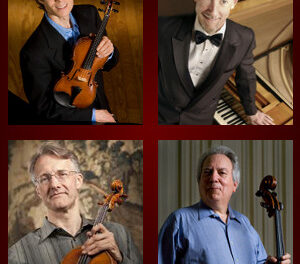The East Carolina University Symphony Orchestra under the direction of Dr. Jorge Richter presented its second concert of the academic year on Wednesday, December 2. The orchestra played the first work on the program, Symphony No. 9 in E minor, Op. 95, “From the New World” by Antonín Dvořák (1841-1904), exceptionally well, and its American idioms made it a fitting antecedent to the world première of Dr. Mark Alan Taggart’s Symphony of Spirituals, performed by the orchestra and Dr. Louise Toppin, member of the ECU voice faculty.
Following the performance of Symphony No. 9 and intermission, the orchestra returned to the stage with their ranks amended by harp, piano, saxophone, and an expanded percussion section. Drs. Richter and Toppin entered to warm applause, each having earned the respect and affection of their colleagues at the School of Music as well as the community of eastern North Carolina as a whole.
The first movement of Symphony of Spirituals, “Peace – Lento,” was written “in memoriam to all of those who lost their lives due to the atrocities on September 11, 2001 and to their friends and family.” The movement is a haunting reharmonization of “Sometimes I Feel Like a Motherless Child,” the song that came to mind as the composer watched the scenes of that day. Taggart’s scoring creates an undulating dark sea of sound, and the dominant rhythmic motive is taken up and perpetuated by the chimes, which are traditionally associated with funeral processions. The vocal line begins as a beautifully stylized vocalise of grief, the first of several textless passages that occur throughout the work. A direct modulation to the major mode introduces a sense of peacefulness with the song, “There is a Balm in Gilead.” The colors and harmonies of the movement are unusual and serve the text well, and the vocal part is lovely. This section could stand alone in performance.
In typical symphonic style, the middle movements are less rigorous than the first. They are more akin to arrangements than transformations of the original material, as was the opening movement. The second movement, “Hope – Con moto”, featuring “O Peter Ring Dem Bells,” and “Guide My Feet,” and the third, “Faith – Lively,” are unified by similar dance-like rhythmic motives in duple and triple time, respectively, and by Taggart’s dedication of them to two friends and colleagues, Catherine A. Rigsby and, in memoriam, Linda Allred.
The opening “Git on Board” of the third movement is great fun, and the orchestral text painting of the heavenly train is ideal accompaniment to the vocal line. This lively song is paired with the contrasting “Welcome to the Dyin’ Lamb,” and the movement ends with a very brief reprise of “Git on Board.” Rather than this somewhat startling return, would it be effective to maintain the somber mood of “Welcome to the Dyin’ Lamb” by moving directly into the restrained opening of the fourth movement?
In the finale, “Love – Warmly,” dedicated to the composer’s wife Lee Ann, Taggart deftly pairs the subdued strength of “Let Us Break Bread Together” and the stirring testimony, “God is a God! God don’t ever change! The earth’s His footstool and heaven’s His throne; the whole creation, all His own; His love and power will prevail, His promises will never fail!”
Taggart began this project, initially for voice and piano trio, at Ms. Toppin’s request for a setting of spirituals. Because it was written with her in mind, the vocal part is very difficult. Among her many operatic roles Dr. Toppin lists “Queen of the Night,” which is an indication of her vocal range and ability. The Symphony of Spirituals makes full use of her exceptional voice, and she gave an exquisite performance.
It could be said that one measure of the artistic success of a piece is the degree to which it alters the listener’s perception of time. Time was suspended during this performance by Louise Toppin, Jorge Richter, and the ECU Symphony Orchestra. The music was sublime; it left the listener wanting more. Surely these perceptions alone are more than sufficient to define the aesthetic success of Mark Alan Taggart’s newly born composition, Symphony of Spirituals.













